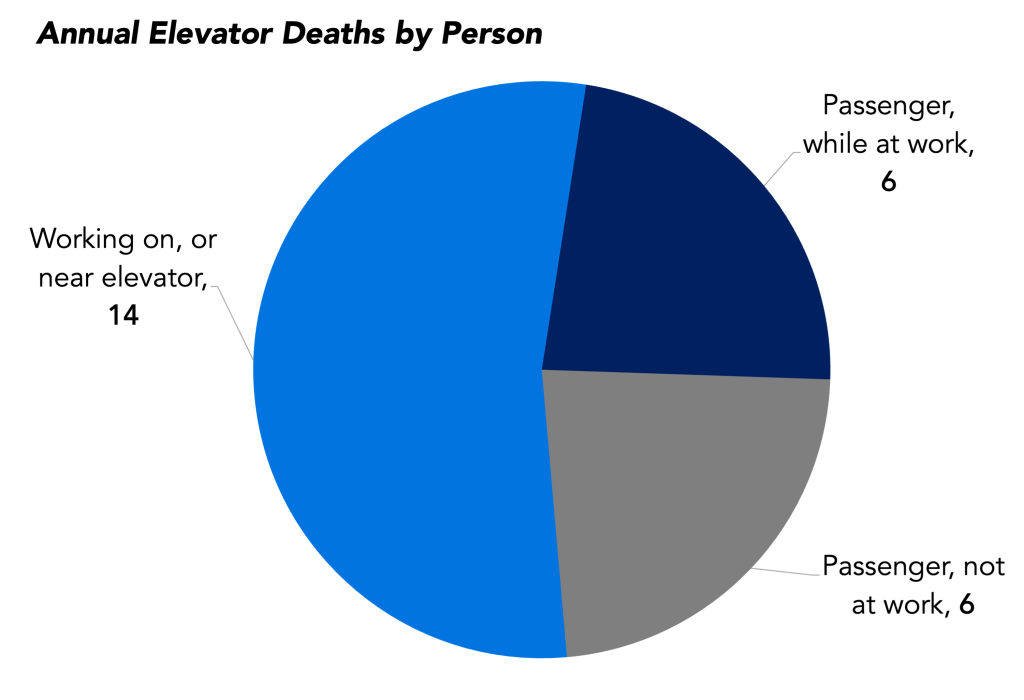Elevators are such an integral part of our daily lives that we rarely consider them or think twice about stepping inside and letting the doors close behind us. Elevators have existed since early Greek and Roman history as man-powered hoist and pulley systems, but have advanced along with technology to the electric elevators we know and depend on today. But how safe are elevators? We’ve all seen elevator disasters depicted in Hollywood movies, but how many elevator accidents actually occur, and what types of accidents and personal injuries happen on elevators?

Quick Links
- List of Elevator Accidents in 2025
- How Often Do Elevators Fall?
- How Many People Are Injured in Elevators Each Year?
- Causes of Elevator Accidents
- Who Dies on Elevators?
- Surprising Statistics on Elevator Accidents
- Who is Responsible for Elevator Hazards?
List of Notable Elevator Accidents in 2025
- On January 26th, a worker fell into an elevator shaft in Savannah, Georgia. Firefighters responded to the incident where the victim was promptly removed with minor injuries. It is currently unknown if a malfunction caused the accident.
- On January 28th, a construction worker in Houston was trapped in an elevator following the collapse of scaffolding at the construction site. An investigation revealed that concrete fell on top of the scaffolding and landed on the elevator box. The man was taken to the hospital in stable condition.
- On January 29th, a psychiatric patient at the West Virginia Department of Health Facilities suffered injuries in an elevator shaft while attempting to flee. The victim was taken to another hospital for medical treatment.
- On February 3rd, a 78-year-old man was found unconscious after falling down an elevator shaft in the Bronx. It is unknown how the man ended up there.
- On February 28th, a toddler got his hand stuck in an elevator door aboard the Carnival Panorama. The child received treatment on the ship for a laceration. The parents allege that the elevator doors lack sensors to prevent this type of injury.
How Often Do Elevators Fall?
Thriller movies often show an elevator plunging down a long shaft in a freefall, but that type of elevator accident hasn’t happened since 1932 when a cable-operated elevator fell down a shaft in Brazil. Since then, elevators have backup cables, emergency braking systems, and shaft stoppers that don’t allow an elevator to fall down the shaft. However, this doesn’t mean that elevator accidents don’t occur, only that they don’t happen the way they do in movies.
How Many People Are Injured in Elevators Each Year?
According to the Consumer Product Safety Commission and reports from the Bureau of Labor Statistics, about 17,000 people suffer elevator-related injuries in the U.S. each year. Half of the fatalities of workers in or near elevator shafts were due to falls into the elevator shafts.
Causes of Elevator Accidents
Most elevator accidents can be prevented with regular inspections and proper maintenance. However, property owners can easily overlook common sense safety strategies which leads to preventable tragedies. Here are some of the most common causes of elevator accidents:
- Mechanical failures
- Improper maintenance
- Electrical failure
- Door malfunctions
- Mis-leveling
- Failure to display warning sings
Who Dies on Elevators?
According to a study conducted between 1992 and 2003, the yearly average of deaths involving elevators are as follows:

Passengers accounted for an average of 12 deaths per year, while those working on, or near elevators accounted for 14 deaths per year.
Surprising Statistics on Elevator Accidents
Both passengers and workers are at risk of experiencing accidents while riding or working on or near elevators. Most elevator injuries do not occur from falling elevators but from passenger falls inside the elevator due to sudden drops or rises, elevator door accidents due to faulty rebound devices and sensor failures, and gaps between floors when an elevator mislevels. Accidents also occur to maintenance workers repairing elevators and elevator shafts. The following elevator accident statistics indicate the scope of the problem:
- Around 900,000 elevators are operating in the U.S., making about 18 billion trips per year
- Around 30 people die in the U.S. each year due to elevator accidents, and over 17,000 suffer injuries
- About half of elevator accident deaths and injuries occur to workers installing or maintaining elevators and shafts
- Half of elevator worker deaths were due to falling into elevator shafts
- Many serious elevator accident injuries occur as “caught-between” accidents when passengers or workers are caught, trapped, or pulled between the moving parts of an elevator or between gaps
- “Struck-by’’ elevator accidents also occur to workers hit by a descending elevator while working in a shaft
- Elevator installers and repair workers have the sixth-highest workplace death rate in the construction and repair trades, with an average death rate of just over 29 deaths per 100,000 full-time workers
- Ten deaths in a 2006 study occurred to untrained building maintenance workers attempting to unjam stalled elevators
- During the same study, three elevator worker deaths were electrocutions
- An eleven-year study revealed 68 elevator passenger deaths in the U.S. or an average of 6 passenger deaths per year
- Children are the most common elevator passengers to suffer injuries
- There were 117,100 recalled elevators in 2022 due to child entrapment hazards
Around 2,000 deaths per year occur in accidents on stairs, compared to 30 elevator accident deaths per year.

Who Is Responsible For Elevator Hazards?
According to the Consumer Product Safety Commission, they are making progress in holding manufacturers accountable for elevator hazards, but determining liability for an elevator accident injury isn’t always that simple. Depending on how the injury occurred and who it happened to, the injury victim could recover compensation through a defective product claim, an inadequate maintenance claim against a property owner, or a workplace injury claim. Calling and collaborating with a Kansas City personal injury lawyer can help guide victims through the legal process and receive compensation faster.

